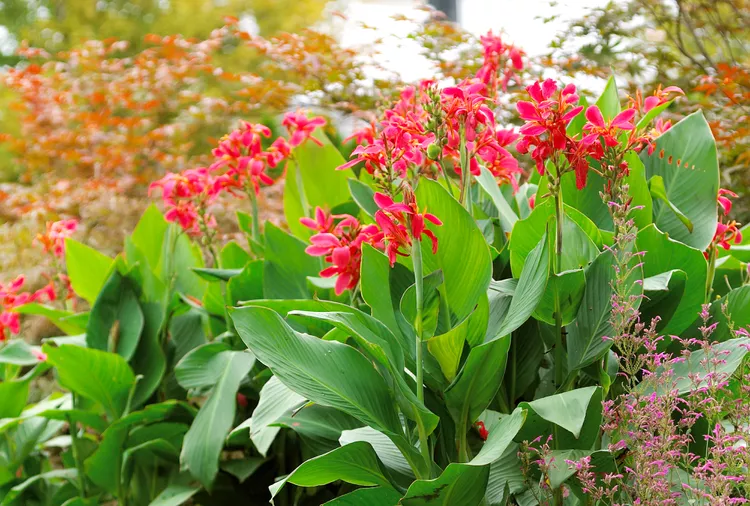Planting cannas in your garden is a little like planting bulbs or tubers, except these plants sprout from thick rhizomes. It might not seem possible that those lumpy rhizomes will grow into giant tropical-looking leaves and brightly colored blooms on tall stalks. But when properly planted and cared for, your cannas will soon reward you with their gorgeous foliage and flowers. Use these tips to guide you when planting cannas from rhizomes you've either purchased fresh or dug up and stored from the previous growing season.
What is a Rhizome?
Rhizomes may look like fleshy roots, but they are actually underground stems with nodes that sprout into shoots. Similar to tubers and bulbs, rhizomes are how some plants store energy underground when they go dormant until more favorable conditions for growth return.
Tips for Planting Cannas from Rhizomes
Get your canna rhizomes on their way to becoming gorgeous, lush, statement plants with these tips and techniques.
1. Select healthy rhizomes.
Choose the best rhizomes to plant and compost the rest. A healthy canna rhizome feels firm with no mushy spots and should be cream or white in color. Rhizomes that have blackened or become soft may be rotting.
Like bulbs, corms, and tubers, a rhizome’s main enemy is rot. Excess moisture, either in storage or once planted, is the end of the line for canna rhizomes. Conversely, canna rhizomes may dehydrate if stored too dry and have a shriveled, wrinkly appearance.
2. Wake them up early.
Many gardeners in regions with short growing seasons wake up their cannas early, about four to six weeks before the last frost date in spring. To do so, plant them in a container (it doesn’t have to be huge), place them in a warm spot, and water them.
They’ll come out of dormancy and start to grow a bit, giving you a jump start of several weeks on the season. You’ll enjoy large tropical foliage and flowers much earlier than if you waited to start the process outside.
3. Don’t plant too deep.
While a few sources claim cannas need to be planted 6 inches deep or more, 3 to 4 inches is enough. Dig the hole so the rhizome can be planted horizontally, and the "eyes" are at least 2 inches below ground. Planting them deeper means more time for them to pop up, possibly resulting in stunted growth.
4. Use huge containers.
When planting cannas in containers, adopt a bigger is better mindset. Some cannas become massive and need space for a giant root system. A pot 18 inches in diameter is about right for one canna (unless it’s a miniature variety). Larger pots can hold two or three.
A second benefit to a giant container for your cannas is mass. Cannas can catch a lot of wind; even a small gust can tip over a 5-foot-tall canna in a 12-inch pot. Lots of soil in the pot and a wider base give your cannas a better chance of staying upright in the occasional summer storm.
5. Wait until tomato planting time.
As you’d guess from their tropical nature, cannas don’t like cold air or soil. Wait until the soil warms to at least 50°F (60°F is better) and all danger of frost is past before planting rhizomes outdoors in the garden. If you don’t have a soil thermometer to check the temperature a few inches down, wait until the recommended time to plant tomato seedlings in your area.
6. Harden them off.
When planting cannas indoors first to wake up the rhizomes, don’t fling them into the garden before giving them some time to adjust to the outdoors. Like any other plant started inside, cannas need to be hardened off before being transplanted outside. The same goes for canna plants purchased from a greenhouse.
7. Know which way is up.
If your canna rhizomes have started to sprout, it is easy to see which side goes up. If they’re still a bit sleepy, you’ll have to look closely to find the "eyes" or buds that will become sprouts. When planting cannas, make sure those eyes are facing up, and remember to plant the rhizome horizontally, not vertically.
8. Order cannas in winter and store until spring.
Popular varieties or new releases often sell out early in the season. Waiting until late spring to order cannas can leave you with a poor selection. If you store canna rhizomes properly, you can order them in winter when everything is still in stock. If they are shipped early, store them for a few months and then wake them up indoors or just plant them outside at the right time.
Don’t forget to keep an eye on the big box stores toward the end of spring. Their need to move inventory and prepare for the next season means they often deeply discount unsold bags of canna rhizomes and other summer-blooming bulbs like gladiolus just at the right time for planting them outdoors.




















